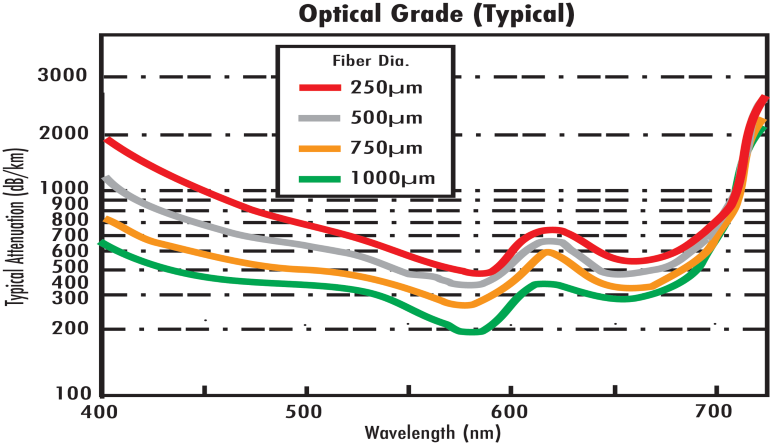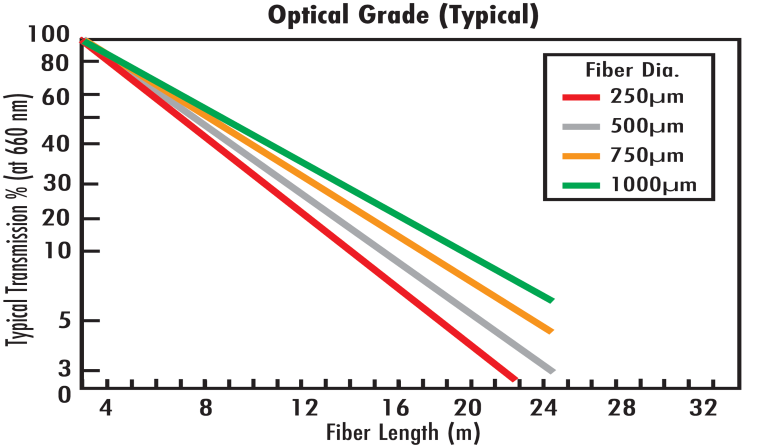
Unsere Fasern optischer Güte werden von Mitsubishi hergestellt und in zwei Güteklassen angeboten, beide mit hervorragenden optischen Eigenschaften und verbesserter Transmission. Der Kern beider Fasern ist aus dem Acrylpolymer PMMA (Polymethyl-Methacrylat) hergestellt und mit einer besonderen dünnen Schicht aus Fluorpolymer ummantelt, die einen niedrigeren Brechungsindex als der Kern hat. Fasern optischer Güte können von industriellen Lichtleiteranwendungen bis hin zur Datenübertragung über kurze Distanz für eine Vielzahl von Anwendungen eingesetzt werden. Die Faser ist stark und flexibel, aber nicht dazu ausgelegt große Lasten auszuhalten.
Bitte beachten Sie: Der angegebene Preis bezieht sich auf einen Fuß, minimale Bestellmenge 10 Fuß. Die 3-mm-Faser ist eine Eska® Faser niedrigerer Güteklasse, die nur für kommerzielle Anwendungen geeignet ist.
| Titel | Vergleichen | Artikelnummer | Preis | Kaufen | |
|---|---|---|---|---|---|
| 250 μm mit einer Faser, optische Plastikfaser mit Hülle | #57-096 | €1,60 Angebotsanfrage |
|
||
| 265 μm mit 16 Fasern, optische Plastikfaser mit Hülle | #02-537 | €3,00 Angebotsanfrage |
|
||
| 265 μm mit 64 Fasern, optische Plastikfaser mit Hülle | #02-540 | €3,75 Angebotsanfrage |
|
||
| 500 μm mit einer Faser, optische Plastikfaser mit Hülle | #57-097 | €2,20 Angebotsanfrage |
|
||
| 1000 μm mit einer Faser, optische Plastikfaser mit Hülle | #02-536 | €4,00 Angebotsanfrage |
|
||
| 1500 μm mit einer Faser, optische Plastikfaser mit Hülle | #02-550 | €4,25 Angebotsanfrage |
|
||
| 2000 μm mit einer Faser, optische Plastikfaser mit Hülle | #02-551 | €5,50 Angebotsanfrage |
|
||
| 250 μm, optische Plastikfaser ohne Hülle | #02-531 | €1,00 Angebotsanfrage |
|
||
| 500 μm, optische Plastikfaser ohne Hülle | #02-532 | €1,50 Angebotsanfrage |
|
||
| 750 μm, optische Plastikfaser ohne Hülle | #02-533 | €1,75 Angebotsanfrage |
|
||
| 1000 μm, optische Plastikfaser ohne Hülle | #02-534 | €2,00 Angebotsanfrage |
|
||
| 1500 μm, optische Plastikfaser ohne Hülle | #02-535 | €2,75 Angebotsanfrage |
|
||
| 2000 μm, optische Plastikfaser ohne Hülle | #02-549 | €4,00 Angebotsanfrage |
|
||
| 3000 μm, optische Plastikfaser ohne Hülle | #53-833 | €4,60 Angebotsanfrage |
|



1-800-363-1992
weitere regionale Telefonnummern
ANGEBOTSTOOL
Geben Sie zum Starten die Produktnummer ein.
Copyright 2025 | Edmund Optics, Ltd Unit 1, Opus Avenue, Nether Poppleton, York, YO26 6BL, UK
Die Edmund Optics GmbH Deutschland fungiert als Handelsvermittler für die Edmund Optics Ltd. in Großbritannien.
Vertragspartner ist die Edmund Optics Ltd. in Großbritannien.